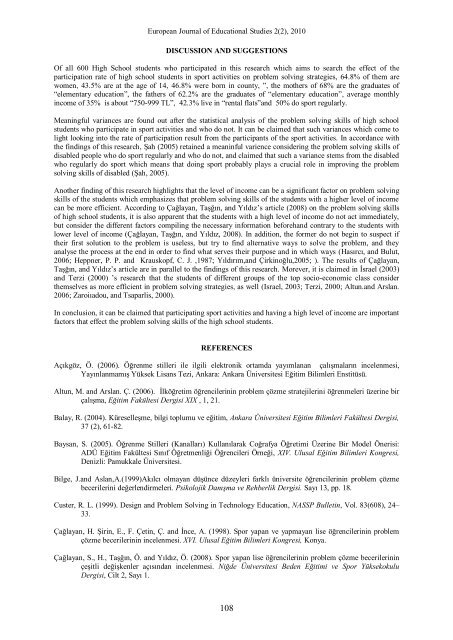Educational - Ozean Publications
Educational - Ozean Publications
Educational - Ozean Publications
You also want an ePaper? Increase the reach of your titles
YUMPU automatically turns print PDFs into web optimized ePapers that Google loves.
European Journal of <strong>Educational</strong> Studies 2(2), 2010DISCUSSION AND SUGGESTIONSOf all 600 High School students who participated in this research which aims to search the effect of theparticipation rate of high school students in sport activities on problem solving strategies, 64.8% of them arewomen, 43.5% are at the age of 14, 46.8% were born in county, ”, the mothers of 68% are the graduates of“elementary education”, the fathers of 62.2% are the graduates of “elementary education”, average monthlyincome of 35% is about “750-999 TL”, 42.3% live in “rental flats”and 50% do sport regularly.Meaningful variances are found out after the statistical analysis of the problem solving skills of high schoolstudents who participate in sport activities and who do not. It can be claimed that such variances which come tolight looking into the rate of participation result from the participants of the sport activities. In accordance withthe findings of this research, Şah (2005) retained a meaninful varience considering the problem solving skills ofdisabled people who do sport regularly and who do not, and claimed that such a variance stems from the disabledwho regularly do sport which means that doing sport probably plays a crucial role in improving the problemsolving skills of disabled (Şah, 2005).Another finding of this research highlights that the level of income can be a significant factor on problem solvingskills of the students which emphasizes that problem solving skills of the students with a higher level of incomecan be more efficient. According to Çağlayan, Taşğın, and Yıldız‟s article (2008) on the problem solving skillsof high school students, it is also apparent that the students with a high level of income do not act immediately,but consider the different factors compiling the necessary information beforehand contrary to the students withlower level of income (Çağlayan, Taşğın, and Yıldız, 2008). In addition, the former do not begin to suspect iftheir first solution to the problem is useless, but try to find alternative ways to solve the problem, and theyanalyse the process at the end in order to find what serves their purpose and in which ways (Hasırcı, and Bulut,2006; Heppner, P. P. and Krauskopf, C. J. ,1987; Yıldırım,and Çirkinoğlu,2005; ). The results of Çağlayan,Taşğın, and Yıldız‟s article are in parallel to the findings of this research. Morever, it is claimed in İsrael (2003)and Terzi (2000) ‟s research that the students of different groups of the top socio-economic class considerthemselves as more efficient in problem solving strategies, as well (Israel, 2003; Terzi, 2000; Altun.and Arslan.2006; Zaroiıadou, and Tsaparlis, 2000).In conclusion, it can be claimed that participating sport activities and having a high level of income are importantfactors that effect the problem solving skills of the high school students.REFERENCESAçıkgöz, Ö. (2006). Öğrenme stilleri ile ilgili elektronik ortamda yayımlanan çalışmaların incelenmesi,Yayınlanmamış Yüksek Lisans Tezi, Ankara: Ankara Üniversitesi Eğitim Bilimleri Enstitüsü.Altun, M. and Arslan. Ç. (2006). İlköğretim öğrencilerinin problem çözme stratejilerini öğrenmeleri üzerine birçalışma, Eğitim Fakültesi Dergisi XIX , 1, 21.Balay, R. (2004). Küreselleşme, bilgi toplumu ve eğitim, Ankara Üniversitesi Eğitim Bilimleri Fakültesi Dergisi,37 (2), 61-82.Baysan, S. (2005). Öğrenme Stilleri (Kanalları) Kullanılarak Coğrafya Öğretimi Üzerine Bir Model Önerisi:ADÜ Eğitim Fakültesi Sınıf Öğretmenliği Öğrencileri Örneği, XIV. Ulusal Eğitim Bilimleri Kongresi,Denizli: Pamukkale Üniversitesi.Bilge, J.and Aslan,A.(1999)Akılcı olmayan düşünce düzeyleri farklı üniversite öğrencilerinin problem çözmebecerilerini değerlendirmeleri. Psikolojik Danışma ve Rehberlik Dergisi. Sayı 13, pp. 18.Custer, R. L. (1999). Design and Problem Solving in Technology Education, NASSP Bulletin, Vol. 83(608), 24–33.Çağlayan, H. Şirin, E., F. Çetin, Ç. and İnce, A. (1998). Spor yapan ve yapmayan lise öğrencilerinin problemçözme becerilerinin incelenmesi. XVI. Ulusal Eğitim Bilimleri Kongresi, Konya.Çağlayan, S., H., Taşğın, Ö. and Yıldız, Ö. (2008). Spor yapan lise öğrencilerinin problem çözme becerilerininçeşitli değişkenler açısından incelenmesi. Niğde Üniversitesi Beden Eğitimi ve Spor YüksekokuluDergisi, Cilt 2, Sayı 1.108
















